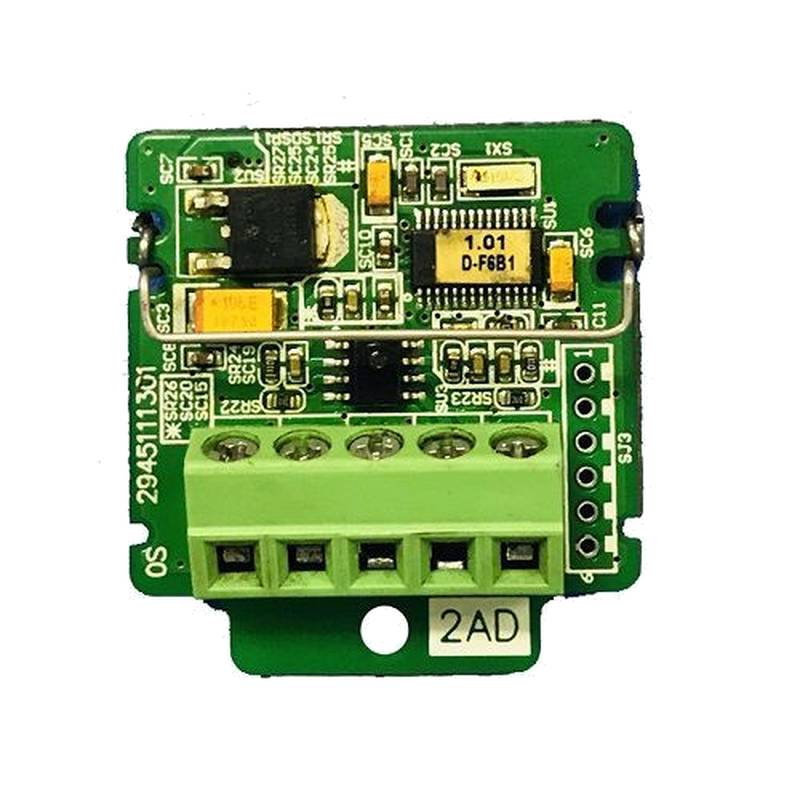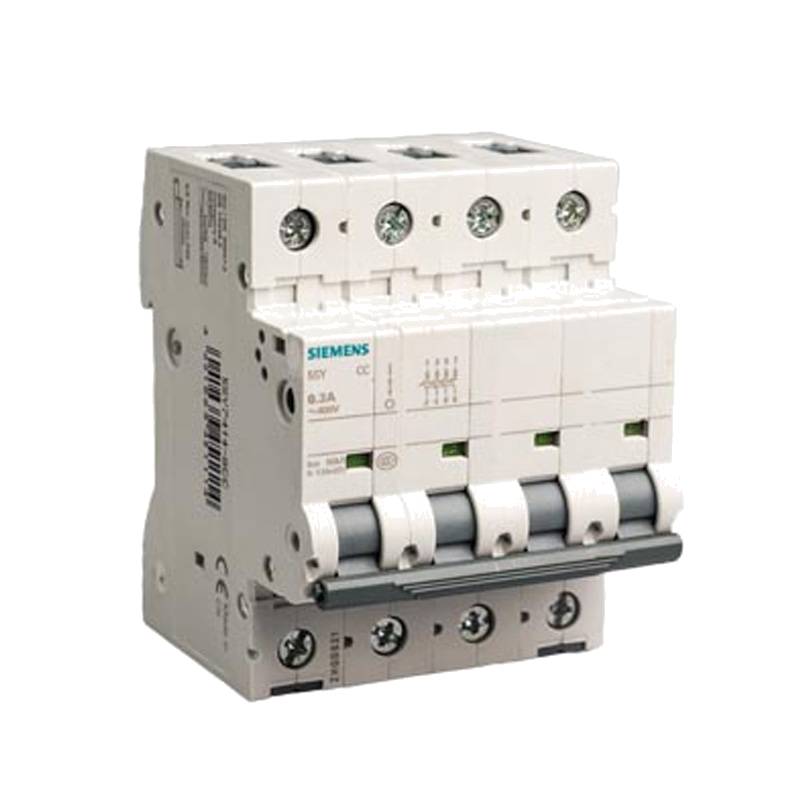
The Siemens 5SY6520-7CC is a robust double-pole circuit breaker designed for medium to high current applications, offering reliable protection for single-phase plus neutral circuits up to 20A. This unit distinguishes itself with its compact design, high breaking capacity, and enhanced safety features, making it a preferred choice for demanding industrial and commercial installations. Its construction adheres to stringent international standards, ensuring dependable performance in critical environments.
Siemens 5SY6520-7CC: Product Specifications
| Feature | Specification |
| :------------------------ | :------------------------------------------ |
| Product Type | Double Pole Circuit Breaker |
| Poles | 1P + N (Single Pole + Neutral) |
| Rated Current (In) | 20A |
| Breaking Capacity (Icn) | 10kA (IEC 60947-2) |
| Tripping Characteristic | Curve C |
| Voltage Rating (Un) | 230/400V AC |
| Frequency | 50/60 Hz |
| Terminal Type | Screw terminals |
| Mounting Type | DIN Rail (35mm) |
| IP Rating | IP20 (enclosure) |
| Operating Temperature | -25°C to +45°C |
| Approvals | CE, IEC |
| Model Number | 5SY6520-7CC |
Core Features & Market Positioning
The Siemens 5SY6520-7CC leverages Siemens' extensive experience in electrical protection, positioning itself as a reliable and high-performance solution for industrial power distribution. Its double-pole configuration ensures simultaneous disconnection of both the live and neutral conductors, a critical safety feature for specific circuits and applications. The 10kA breaking capacity provides substantial fault current handling capability, protecting downstream equipment from severe damage. Its Curve C tripping characteristic is optimized for inductive loads, offering excellent discrimination between normal operation and short-circuit events, thereby minimizing nuisance tripping. This combination of features makes it a competitive offering against other high-quality circuit breakers in its class, particularly where robust protection and compliance with rigorous industrial standards are paramount.
Key Application Scenarios
This Siemens circuit breaker finds its primary utility in controlling and protecting circuits that require reliable interruption of both the phase and neutral lines. Common scenarios include the protection of motor circuits, transformers, and other inductive loads in industrial settings. It is frequently specified for control panels, power distribution boards, and machinery where precise and dependable overcurrent and short-circuit protection is essential. The 20A rating makes it suitable for a range of medium-power applications, such as HVAC systems, pumps, and conveyor systems. Its application extends to commercial buildings for specific power circuits requiring enhanced safety and protection protocols.
Practical System Integration Guidance
Integrating the Siemens 5SY6520-7CC into an electrical system is a straightforward process, owing to its standard DIN rail mounting and accessible screw terminals. Installers must ensure the circuit breaker is mounted vertically on a 35mm symmetrical top-hat DIN rail. For secure connections, strip the wire insulation to the appropriate length as indicated on the terminal and insert it firmly, then tighten the terminal screw to the recommended torque specification (typically found in Siemens installation manuals, often around 2-3 Nm). Proper wire sizing is crucial; consult local electrical codes and the product's technical datasheet to ensure the conductor gauge is adequate for the 20A rating and the specific installation environment to prevent overheating. Always ensure the main power supply is de-energized before commencing any installation or wiring work.
Operation and Risk Mitigation
The Siemens 5SY6520-7CC operates by continuously monitoring the current flowing through its poles. Should the current exceed a predetermined threshold due to overload or a short circuit, an internal tripping mechanism is activated, rapidly opening the contacts and interrupting the power flow. This action prevents damage to connected equipment and mitigates fire hazards associated with electrical faults. Risk mitigation is inherent in its design, including the double-pole switching for complete isolation. Users should be aware that while designed for robustness, regular inspection and testing are recommended to ensure continued optimal performance. Common troubleshooting involves checking for loose connections or verifying that the fault has been cleared before resetting the breaker; however, persistent tripping indicates a deeper electrical issue requiring professional diagnosis.
Scalability & Long-Term Value
The Siemens 5SY6520-7CC offers excellent long-term value through its compatibility with the broader Siemens industrial automation and control ecosystem. Its standard form factor and electrical characteristics ensure it can be seamlessly integrated into new control panels or used as a direct replacement for older Siemens or compliant breakers. While this specific model is a standalone protective device, its reliable performance contributes to the overall stability and longevity of the electrical system it protects. For facilities looking to embrace digitalization, integrating such components into an intelligent power distribution system allows for remote monitoring and data logging capabilities, which can be achieved through compatible Siemens energy monitoring modules and communication interfaces.
Frequently Asked Questions
1. What is the breaking capacity of the Siemens 5SY6520-7CC?
The Siemens 5SY6520-7CC boasts a significant breaking capacity of 10kA.
This high rating ensures it can safely interrupt fault currents up to 10,000 amperes.
It complies with IEC 60947-2 standards, guaranteeing robust fault protection.
2. Can this circuit breaker be used for single-phase applications?
Yes, it is designed for single-phase circuits with neutral.
It protects both the phase and neutral conductors simultaneously.
This dual-pole operation enhances safety in specific electrical configurations.
3. What type of loads is the Siemens 5SY6520-7CC best suited for?
It is ideal for inductive loads like motors and transformers.
The Curve C tripping characteristic provides optimal protection for these applications.
It offers reliable overcurrent and short-circuit protection for various industrial equipment.
4. How is the Siemens 5SY6520-7CC installed?
Installation is via a standard 35mm DIN rail.
Wiring connections are made using accessible screw terminals.
Ensure power is off and follow torque specifications for secure connections.
5. What does "1P+N" mean in the product name?
"1P+N" signifies a single-pole plus neutral configuration.
This means both the live and neutral wires are switched by the breaker.
It provides complete isolation of the circuit from the power source.
6. What is the significance of the "C" curve on this breaker?
A "C" curve indicates its tripping response for inrush currents.
It is designed to withstand moderate surge currents, typical of inductive loads.
This reduces nuisance tripping while still protecting against short circuits.
7. Is the Siemens 5SY6520-7CC suitable for residential use?
While it meets high standards, it's primarily an industrial-grade breaker.
Its 10kA rating and double-pole function are often specified for commercial/industrial settings.
Consult local electrical codes for specific residential application suitability.
8. What is the rated current and voltage for this model?
The rated current (In) for the 5SY6520-7CC is 20 Amperes.
Its operational voltage rating (Un) is typically 230/400V AC.
Always verify these ratings against your specific circuit requirements.
9. Where can I find the user manual or technical datasheet?
Technical documentation is available on the official Siemens Industry website.
Search for the product number "5SY6520-7CC" on their support portal.
Installation and operating instructions are critical for safe and correct use.
10. What are common troubleshooting steps if the breaker trips frequently?
First, ensure the fault condition has been cleared.
Check for loose wire connections at the breaker terminals.
If tripping persists, a professional electrician should inspect the circuit for underlying issues.

























